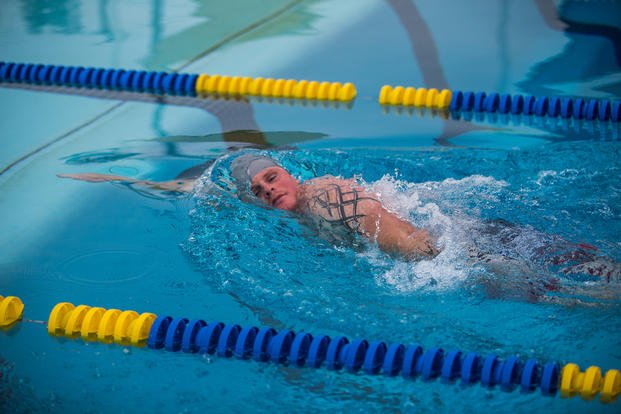People often ask about tips to help with swimming. Here is a typical email that will truly require a video to explain the stroke this young man seeks to learn:
Hi, Stew,
I recently started critical swim speed training. I have tried it with both the breaststroke and scissor kick. When I use the breaststroke kick, my body stays flat during the glide phase (my chest is facing the bottom of the pool). However, when I use the scissor kick and my hips rotate during the kick, then my body has a tendency to stay sideways during the glide phase (the side of my torso and hip is facing the bottom of the pool). This feels like it is the natural body movement after the rotation. Should I be concerned as to whether I glide flat or sideways with the scissor kick?
Also, when I put fins on, my kick off the wall is almost nonexistent, even though my 25-yard time is still about the same. Should I do something different to get a better kick off the wall with fins?
Thanks, Jeff
Jeff, great question. Here’s my advice:
1. People use either a scissor kick or breaststroke kick with this stroke. I tend to teach either one, but it depends upon their athletic history. If you’re a swimmer, you typically have a natural breaststroke kick whereas a running athlete will be better at a scissor kick (from my experience). See video:
You can glide on your side or belly. It's up to you. I prefer a scissor kick with a glide on the belly, as the video above shows. The goal to the glide is to make sure you are underwater a few inches so the surface tension does not slow you down.
2. Swimming with fins is a different animal (see link). You want to stay on your side so you can get good kicks when using scissor kicks or flutter kicks. Some even use dolphin kicks with fins, but the kick off the wall is awkward. Push off flat-footed, but quickly relax your feet and do a few dolphin kicks to gain momentum quickly off the wall. Then, do your normal kicking sequence, using the arms to regulate your breathing.
Full 500-yard swim video, with two swimming under eight minutes doing the CSS.
Honestly, if I could teach swimming (or you could learn swimming) by a book, article or email, I would be a remarkable swim coach, and you would be an unbelievable athlete to learn skills by simply reading them. In my experience, this does not happen perfectly. You need to get in the water and practice. Watching swim videos is helpful, and getting a video critique from a coach is helpful, but the best way to learn is by watching others swim with perfection. Practice that technique and receive immediate feedback on your stroke.
Stew Smith is a former Navy SEAL and fitness author certified as a Strength and Conditioning Specialist (CSCS) with the National Strength and Conditioning Association. Visit his Fitness eBook store if you’re looking to start a workout program to create a healthy lifestyle. Send your fitness questions to stew@stewsmith.com.
Want to Learn More About Military Life?
Whether you're thinking of joining the military, looking for fitness and basic training tips, or keeping up with military life and benefits, Military.com has you covered. Subscribe to Military.com to have military news, updates and resources delivered directly to your inbox.


















